

The Educational Directorate of the Krachi Nchumuru District is divided into four Educational Circuits which runs 160 public and 27private schools, for an efficient and effective management of educational institutions of the district. These circuits are Borae, Banda, Chinderi and Grubi. Table 19 presents public private educational institutions in the district.
School Enrolment
The district has an encouraging enrolment figures as most of the schools have over four hundred (200) pupils this
is due largely to good government policies programme such as School Feeding Programme, Free School Uniforms and Exercise Books and the Capitation Grant and the District Assembly’s commitment to provide adequate school infrastructure. Table below indicates the current enrolment figures in the district, particularly in the public schools.
Enrolment Patterns in Public Schools in Krachi Nchumuru District in 2013/2014 Academic Year
The high enrolment level has the potential of putting pressure on existing inadequate educational infrastructure but has the tendency to increase the low literacy rate in the district, as more people will be able to read and write.
One of the major factors that contribute to the high gross enrolment rates in all educational levels is the satisfactory survival rates the district has been recording in the schools for the past years.
The survival rates in the district are 31.15%, 56.2 and 0% for pre-school, primary one to primary six and JHS one to JHS three respectively. The increase in enrolment has the potential of increasing the literacy rate in the district. Considering the pupil teacher ratio at the primary and JHS school level, the district needs extra teachers and additional infrastructure facilities to meet the increasing number of school pupils.
School Infrastructure
Generally, school infrastructure or facilities in the Krachi Nchumuru District are quite inadequate in terms of numbers and quality. On the contrary, the situation in the only Senior Secondary School in the district is going to be different pending the completion of the Community Senior High School Complex. The school in a year shall have adequate classrooms, library facilities, and logistics particularly means of transport.
Teacher accommodation in the district is almost non-existent in the communities as more than 90% of all basic schools Teachers lack good accommodation. Many teachers, therefore, have to travel or walk long distances to schools from nearby towns.
Teacher/ Staffing Situation
The total number of teachers in the pre- and basic schools in the district has increased from 245 in 2012 to 253 in 2013. Out of this figure, 139 (55%) are trained and this is not only woefully inadequate but also unacceptable. Thus, the majority (45%) of the teachers are untrained as shown in Table 21. However, the total teaching staff strength required by the district is 1,103. Generally, the staffing situation can be described as poor in terms of both quality and quantity.
The general poor staffing situation in the district could be attributed to the deprived nature of the district. The district lacks basic infrastructure facilities such as electricity, potable water, communication facilities, and good roads. There is also lack of incentive packages such as accommodation and allowances to motivate teachers to accept posting to the district.
The staffing situation in the district has serious implication for development in terms of poor performance of basic schools and human resource development. The performance of pupils in Basic Education Certificate Examination (BECE) for previous year does not promote human resource development of the district in particular and the country as a whole.
Pupil Teacher Ratio
The pupil-teacher ratio (PTR) in the district for Pre-School, Primary School and JSS are 1:1123, 1:68 and 1:46 respectively as compared to the national standard of 1:35 for both Pre-School and Primary School, and 1:30 for JSS. Thus, in the district, the PTR for pre-school is abnormal while the ratio for primary school is far higher than the national standard. The PTR for JSS is almost equal to the national average.
Considering the district PTR as against the national average, effective teaching and learning and general performance of the public basic schools in the district are seriously affected.
School Performance
Poor school performance in the district is getting out of hand as can be seen from the table below.
The poor performance could be attributed to inadequate teaching and learning materials, inadequate teaching staff as well as lack of logistics for supervision on the part of Ghana Education Service. Furthermore, most parents do not much show interest in their children’s education but rather they spend much on expensive funerals and other unnecessary activities. This phenomenon has serious implication for the district human resource base for future development.
Community Participation and Involvement in Education
Generally, most of the Parent -Teacher Associations and School Management Committees in the district are not active and supportive. As a result, community participation in educational delivery at the local level is almost non-existent in most communities. There is some form of apathy on the part of community members towards the execution of school programmes. Most parents do not provide their wards with basic school needs such as uniforms, stationery, footwear, and school bags. Community participation in school management is poor and this does not augur well for implementation of school programme
Date Created : 11/23/2017 1:44:19 AM











 facebook
facebook
 twitter
twitter
 Youtube
Youtube
 +233 593 831 280
+233 593 831 280 0800 430 430
0800 430 430 GPS: GE-231-4383
GPS: GE-231-4383 info@ghanadistricts.com
info@ghanadistricts.com Box GP1044, Accra, Ghana
Box GP1044, Accra, Ghana